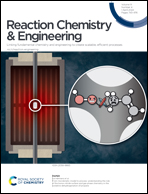Mediated electron transfer in a photo-bioreactor: continuous flow hydroxylation using cytochrome P450 BM3 in NADPH-free conditions†
Abstract
The broad substrate promiscuity of the enzyme cytochrome P450 BM3 (P450 BM3) makes it a candidate in the synthesis of complex chemicals with applications as pharmaceuticals, agrochemicals and biopolymers. The high operational cost of its cofactor, NADPH, has spurred the development of cofactor recycling strategies and synthetic substitutes. Nonetheless, the development of a robust, cofactor-free P450 BM3 enzyme system would be a significant achievement towards the wider implementation of P450 enzymes in large-scale biocatalysis. To this end, we present an efficient alternative to the use of a cofactor, using a low-cost sacrificial electron donor coupled to a photo-activated electron transfer mediator to activate the enzyme. We demonstrate reaction compatibility with P450 BM3 and apply it in a continuous flow reactor that allows for one-step immobilization and purification of P450 BM3 directly from clarified bacterial lysate, streamlining the process and procuring a loading capacity of 100 nmole of enzyme per mL of resin. To this end, a flat, packed-bed continuous flow photoreactor with variable depth reaction chamber and adjustable light intensity was designed. Its high surface area maximizes light exposure for optimal enzyme activation. Optimized reaction conditions allowed full conversion of the substrate in 30 s of residence time. Whereas free P450 BM3 rapidly loses activity, the immobilized enzyme retained 97% residual activity after 72 hours of continuous flow reaction (8640 cycles) and 95% after 40 days of storage at 4 °C. Although the conversion rate using the photo-activated electron transfer reaction is less efficient than that using NADPH, the cofactor-free reaction is ideally suited to continuous flow processes. This proof-of-concept combination of reaction engineering and continuous flow reactor design provides a powerful tool for optimizing P450 BM3 for cofactor-free reactions.



 Please wait while we load your content...
Please wait while we load your content...